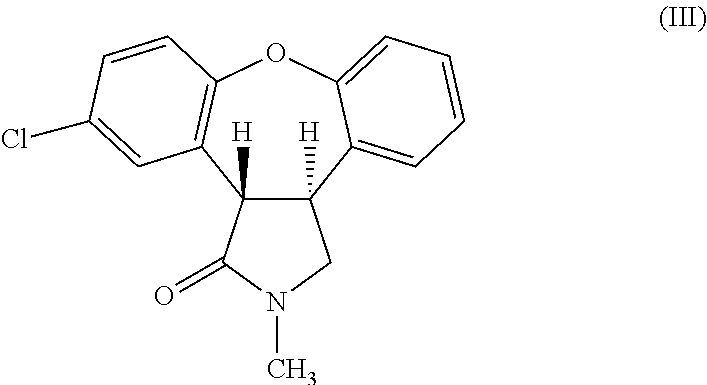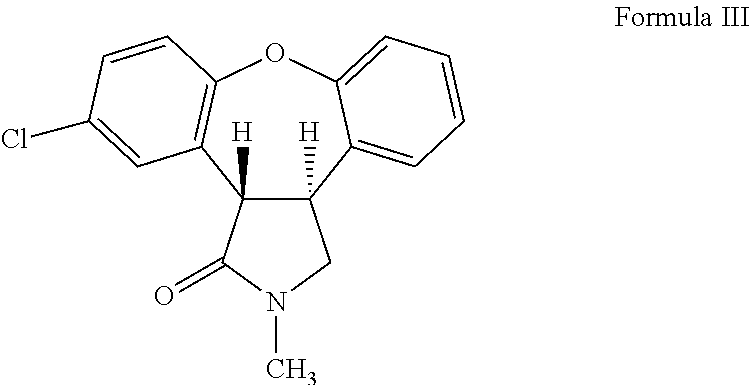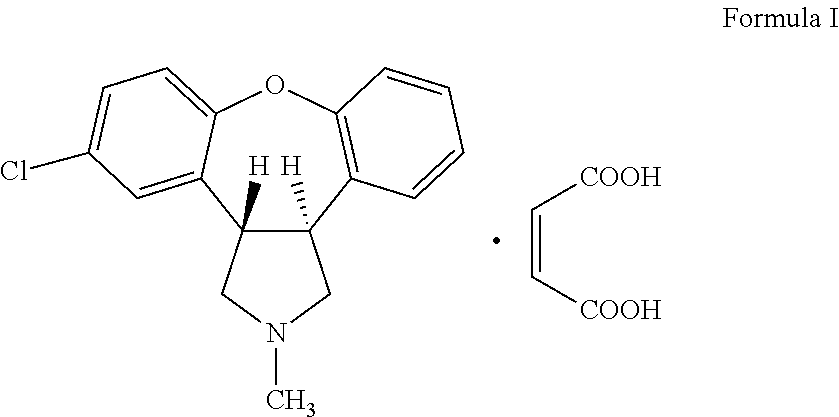Process for the preparation of asenapine intermediate
- Summary
- Abstract
- Description
- Claims
- Application Information
AI Technical Summary
Benefits of technology
Problems solved by technology
Method used
Image
Examples
working examples
Example 1
Preparation of Trans-11-Chloro-2-Methyl-2,3,3a,12b-Tetrahydro-1H-Dibenzo[2,3:6,7]Oxepino[4,5-C]Pyrrol-1-One (Formula III)
[0032]2 g of 11-chloro-2-methyl-2,3-dihydro-1H-dibenzo[2,3:6,7]oxepino[4,5-c]pyrrol-1-one was dissolved in a mixture of methanol (60 mL) and acetic acid (20 mL). The reaction mixture was heated to about 53° C. Magnesium metal turnings (2.0 g) were added portion-wise. The reaction mixture was stirred for about 1 hour, filtered and washed with methanol (100 mL). Methanol was removed by distillation from the filtrate to obtain a white solid (16 g). The white solid was dissolved in dichloromethane (200 mL) and washed with water (2×500 mL). The solid obtained during filtration was also dissolved in water (100 mL) and the aqueous layer was extracted with dichloromethane (50 mL). The two dichloromethane solutions were combined. Dichloromethane was removed by distillation under reduced pressure to obtain a mixture of two isomers as an oily brown compound (2 g). T...
example 2
Preparation of Trans-11-Chloro-2-Methyl-2,3,3a,12b-Tetrahydro-1H- Dibenzo[2,3:6,7]Oxepino[4,5-C]Pyrrol-1-One (Formula III)
[0033]2 g of 11-chloro-2-methyl-2,3-dihydro-1H-dibenzo[2,3:6,7]oxepino[4,5-c]pyrrol-1-one was dissolved in a mixture of methanol (60 mL) and acetic acid (20 mL). The reaction mixture was heated to about 50° C. Magnesium metal turnings (2.38 g) were added portion-wise at about 45° C. to about 65° C. The reaction mixture was stirred at ambient temperature for about 2 hours. Water (80 mL) was added. The pH of the reaction mixture was adjusted to 1 by adding concentrated hydrochloric acid. The reaction mixture was extracted with ethyl acetate (150 mL) and washed with water (3×200 mL). Ethyl acetate was distilled-off to obtain a mixture of two isomers as an oily brown compound (2 g). The mixture of isomers was separated into cis- and trans-isomers using silica gel column chromatography eluting with ethyl acetate:hexane (30:70) mixture.
trans-isomer: 0.7 g
cis-isomer: 0....
example 3
Preparation of Asenapine [Formula IV]
[0034]A 2M solution of borane dimethyl sulphide in tetrahydrofuran (128 mL) was added drop-wise to a pre-heated solution (heated to about 64° C.) of trans-(3a,12b)-11-chloro-2-methyl-2,3,3a,12b-tetrahydro-1H-dibenzo[2,3:6,7]oxepino[4,5-c]pyrrol-1-one (30 g) in tetrahydrofuran (300 mL) at about 64° C. under nitrogen flow. The reaction was allowed to proceed for about 12 hours. Dimethyl sulphide produced during the reaction was slowly removed by distillation from the reaction mixture and fresh tetrahydrofuran was added. Borane dimethylsulphide in tetrahydrofuran 2M solution (24 mL) was added and the reaction mixture was stirred for about 3 hours. Tetrahydrofuran was distilled-off under reduced pressure. Methanol (250 mL) was added to the residue and the reaction mixture was stirred for 15 minutes. A sulphuric acid:water mixture (75 mL:500 mL) was added over about 5 minutes. The reaction mixture was stirred at about 80° C. for about 7 hours, cooled ...
PUM
 Login to View More
Login to View More Abstract
Description
Claims
Application Information
 Login to View More
Login to View More - R&D
- Intellectual Property
- Life Sciences
- Materials
- Tech Scout
- Unparalleled Data Quality
- Higher Quality Content
- 60% Fewer Hallucinations
Browse by: Latest US Patents, China's latest patents, Technical Efficacy Thesaurus, Application Domain, Technology Topic, Popular Technical Reports.
© 2025 PatSnap. All rights reserved.Legal|Privacy policy|Modern Slavery Act Transparency Statement|Sitemap|About US| Contact US: help@patsnap.com



